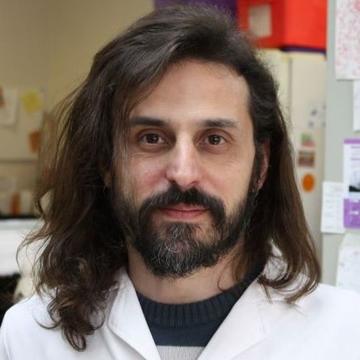Federico Blanco Poster 2023

Dr Federico Blanco
National Institute of Agricultural Technology (INTA), Argentina
Comparative transcriptomic profiles of bovine differentiated macrophages and autologous lymphocytes co-cultures infected with two M. bovis isolates of opposite virulence phenotypes reveals a differential up regulation of type I IFN pathway genes
Poster Abstract
Blanco FC; Bigi MM; Gravisaco MJ; Bigi F
The M. bovis Mb04-303 isolate was previously characterized by our group using in vitro and in vivo models. This wild board isolate of M. bovis is able to produce extended granulomatous lesions and severe pathology in cattle as well as in the mouse and guinea pig model. In a recent publication, we had described the innate immune response elicited by Mb04-303 using an in vitro co-culture model of bovine differentiated macrophages and autologous lymphocytes. In comparison with other two M. bovis isolates, Mb534 and NCTC10772, the innate immune response elicited by Mb04-303 was the only capable of inhibit intracellular mycobacterial replication and was characterized by increased percentages of NKp46+IFNɣ+ cells. In order to decipher the immune mediators involved in this efficient innate immune response we performed transcriptomic analysis of co-cultures infected with Mb534 and Mb04-303, the two strains with opposite virulence phenotypes. Results of the RNA sequencing showed 237 differentially expressed genes (DEGs). Remarkably, the most upregulated genes in co-cultures infected with Mb04-303 are related to the type I IFN activation pathway, as well as several IFN induced genes like RSAD2, ISG15, Mx1, IFIT2 and ISG20. Search Tool for the Retrieval of Interacting Genes/Proteins (STRING) analysis of the RNAseq data showed DEGs networks related to Innate Immune Response, Cellular Immune Response, Antiviral Immune Response and Type I IFN pathway activation. This particular gene expression signature is characterized by recognition of mycobacteria by intracellular pattern recognition receptors (PRRs). On the other hand, whole genome sequence analysis of Mb04-303 revealed a non-synonymous mutation in esat-6, a gene that encodes for an early secreted protein that exhibit pore-forming activity and is involved in mycobacterial phagosome evasion. ESAT-6 forms a dimer with its chaperone CFP10. Using double hybrid assays we demonstrated that the Mb04-303 mutant variant of ESAT-6 has more affinity to form dimers with itself than with the wild type version. The formation of heterodimers with CFP10 is also improved in comparison to the wild type ESAT-6. It is important to mention that formation of heterodimer and homo or hetero multimers between ESAT-6 and CFP10 are relevant for their biological activity. Finally to probe our hypothesis that up regulation of type I IFN genes in co-cultures infected with Mb04-303 is related to different biological activity of the mutant ESAT-6 we deleted esat-6 and cfp10 from Mb04303 (Mb04-303Δesat-6-cfp10) and we determined the activation of the innate immune response by the mutant strain. We found that the mutant strain lost the capacity of activate the innate immune response. Together these results highlight the role of both type I IFN and ESAT-6/CFP10 in the modulation of the innate immune response in the ex vivo infection system used in this study.
Biography
I am an ECR at the National Institute of Agricultural Technologies (INTA) and an associate researcher of the National Council for Scientific and Technical Research (CONICET). My PhD thesis was focused on the study of host-pathogen interaction in bovine tuberculosis (bTB) and bovine immune response towards M. bovis infection. In our laboratory, we follow several lines of investigation related with the characterization of virulence factors of M. bovis and M. tuberculosis, development and evaluation of new candidate vaccines and identification of biomarkers of infection/protection for bTB. After my PhD, I have been mainly focused on the bovine innate immune response against infection using different strains of M. bovis and live attenuated mutants.


